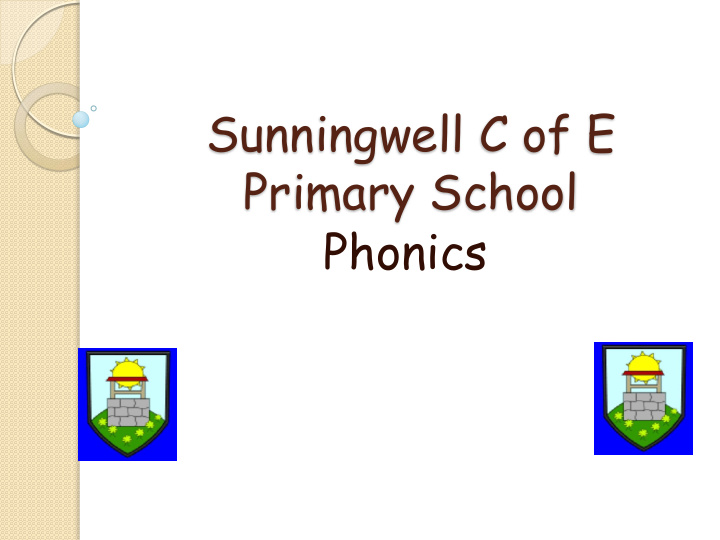



Sunningwell C of E Primary School Phonics
What this evening is about… To give an outline of what we do at Sunningwell C of E in Phonics. To provide you with suggestions of ways to support your child at home.
Phonics In school, we follow the Letters and Sounds programme. Letters and Sounds is a phonics resource published by the Department for Education and Skills which consists of six phases.
Phonics T erminology Phonemes : The smallest units of sound that are found within a word Grapheme : The letter that represents a sound Diagraph : Two letters that make one sound when read (e.g. ch, sh, th) Trigraphs : Three letters that make one sound (e.g. igh, ear) CVC words : Stands for consonant, vowel, consonant. Segmenting is breaking up a word into its sounds. Blending : Putting the sounds together to read a word Tricky words : Words that cannot easily be decoded.
Phase 1 There are 7 aspects – Environmental – Instrumental sounds – Body Percussion – Rhythm and rhyme – Alliteration – Voice sounds – Oral blending and segmenting.
Phase 2 Set 1 : s, a, t, p Set 2 : i, n, m, d Set 3 : g, o, c, k Set 4 : ck, e, u, r Set 5 : h, b, f, ff, l, ll, ss The sounds should be articulated clearly. www.youtube.com/watch?v=BqhXUW_v-1s
Phase 3 Set 6: j, v, w, x Set 7 : y, z, zz, qu Consonant digraphs : ch, sh, th, ng Vowel digraphs : ai, ee, igh, oa, oo, ar, or, ur, ow, oi, ear, air, ure, er
Phase 4 This phase consolidates all the children have learnt in the previous phases. It focuses on reading and spelling longer words with the phonemes children already know.
Phase 5 Children will be taught new graphemes and alternative pronunciations for these graphemes. Vowel digraphs : wh, ph, ay, ou, ie, ea, oy, ir, ue, aw, ew, oe, au Split digraphs : a_e, e_e, i_e, o_e, u_e Learn alternative pronunciations of graphemes ( e.g. Fin/find, hot/cold, cat/cent, got/giant )
Phase 6 The focus is on learning spelling rules for suffixes. -s -es -ing -ed -er -est -y -en -ful -ly -ment -ness
Segmenting Breaking down words for spelling. cat c a t
Blending Building words from phonemes to read. c a t cat
A typical phonics session Revisit/review Practise previously learned letters . Practise oral blending and segmentation T each Teach a new letter Teach blending and/or segmentation with letters Teach one or two tricky words Practice Practise reading and/or spelling words with the new letter Apply Read or write a caption using one or more high frequency words and words containing the new letter
Year 1 Phonics test All children who have reached the end of year 1 must take the phonics screening check. The phonics screening check is designed to confirm whether pupils have learnt phonic decoding to an appropriate standard. The check consists of 20 real words and 20 pseudo-words that a pupil reads aloud to the teacher.
Year 1 Phonics Test
Resources http://www.phonicsplay.co.uk http://www.letters-and-sounds.com
Ideas to support your child with phonics Look for objects around the house that begin with the letter sound you are focusing on at home, for example 'g' for gate, garage, garden, glasses, gloves, grandma Play ‘I spy’ games using the letter sounds . Use a set of magnetic letters on the fridge. Encourage your child to explore mark making/writing regularly. Have a box of assorted and fancy pens and felt pens . Ask them to ‘write’ shopping lists for you – recording initial sounds in the names of objects or recording more or all sounds (according to their stage of writing development).
Thank you for coming!
Recommend
More recommend